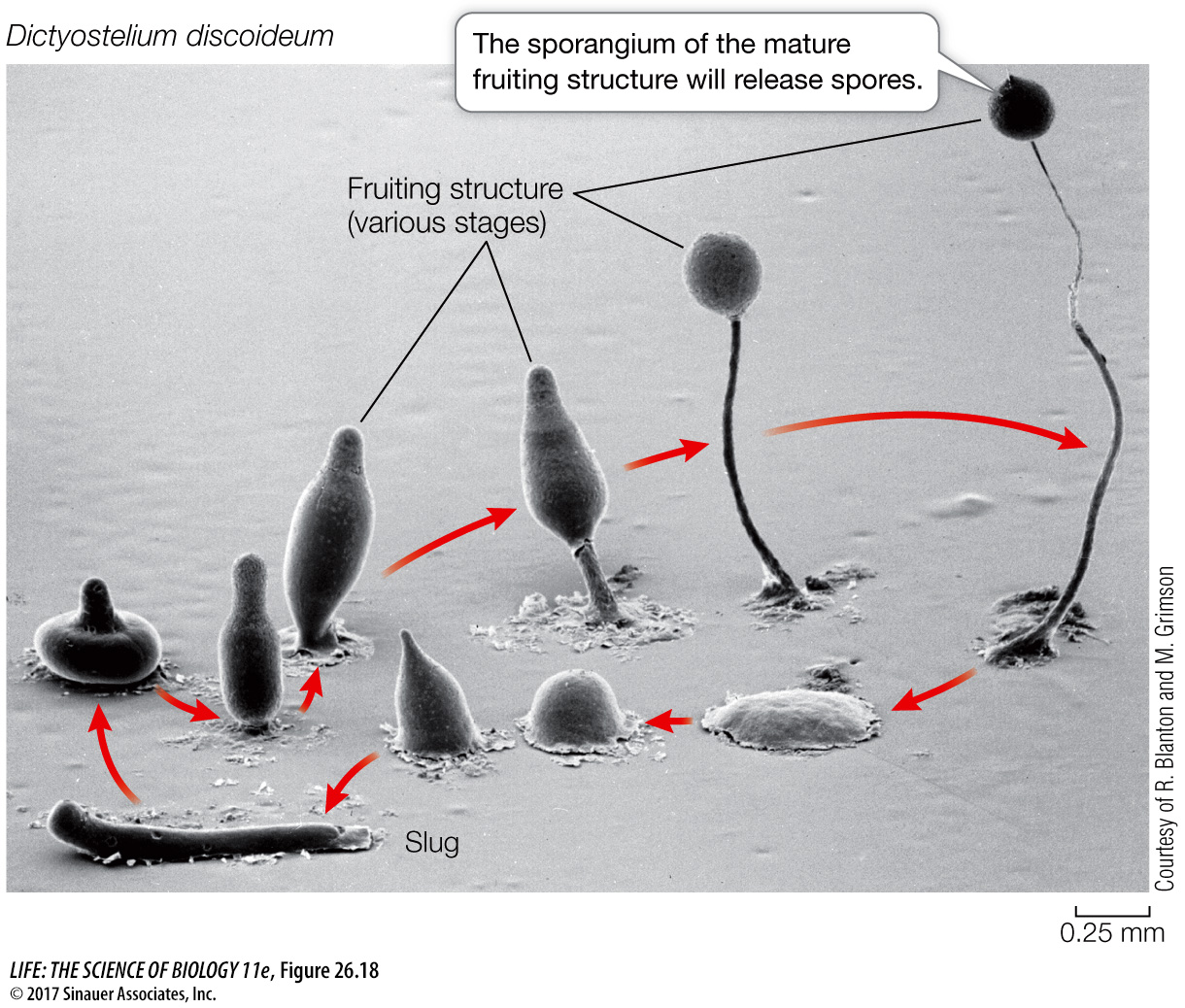Amoebozoans use lobe-

Amoebozoans appear to have diverged from other eukaryotes about 1.5 billion years ago (see Figure 26.3). It is not yet clear whether they are more closely related to opisthokonts (which include fungi and animals) or to other major groups of eukaryotes.
The lobe-

Media Clip 26.5 Amoeboid Movement
www.life11e.com/
563
LOBOSEANS Loboseans are small amoebozoans that feed on other small organisms and particles of organic matter by phagocytosis, engulfing them with pseudopods. Many loboseans are adapted for life on the bottoms of lakes, ponds, and other bodies of water. Their creeping locomotion and their manner of engulfing food particles fit them for life close to a relatively rich supply of sedentary organisms or organic particles. Most loboseans exist as predators, parasites, or scavengers. Members of one group of loboseans, the testate amoebas, live inside shells. Some of these amoebas produce casings by gluing sand grains together (Figure 26.16). Other testate amoebas have shells secreted by the organism itself.

PLASMODIAL SLIME MOLDS If the nucleus of an amoeba began rapid mitotic division, accompanied by a tremendous increase in cytoplasm and organelles, but no cytokinesis, the resulting organism would resemble the multinucleate mass of a plasmodial slime mold. During its vegetative (feeding, nonreproductive) stage, a plasmodial slime mold is a wall-

Media Clip 26.6 Plasmodial Slime Mold Growth
www.life11e.com/
564
Plasmodial slime molds provide a dramatic example of movement by cytoplasmic streaming. The outer cytoplasm of the plasmodium becomes more fluid in places, and cytoplasm rushes into those areas, stretching the plasmodium. This streaming reverses its direction every few minutes as cytoplasm rushes into a new area and drains away from a previous one, moving the plasmodium over its substrate. Sometimes an entire wave of plasmodium moves across a surface, leaving strands behind. Microfilaments and a contractile protein called myxomyosin interact to produce the streaming movement. As it moves, the plasmodium engulfs food particles by endocytosis—
A plasmodial slime mold can grow almost indefinitely in its plasmodial stage as long as the food supply is adequate and other conditions, such as moisture and pH, are favorable. If conditions become unfavorable, however, one of two things can happen. First, the plasmodium can form an irregular mass of hardened cell-
Alternatively, the plasmodium can transform itself into spore-
The spores germinate into wall-
CELLULAR SLIME MOLDS Whereas the plasmodium is the basic vegetative unit of the plasmodial slime molds, a single amoeboid cell is the vegetative unit of the cellular slime molds (Figure 26.18). Cells called myxamoebas, which have single haploid nuclei, swarm together as they engulf bacteria and other food particles by endocytosis and reproduce by mitosis and fission. This simple life cycle stage, consisting of swarms of independent, isolated cells, can persist indefinitely as long as food and moisture are available.

Media Clip 26.7 Cellular Slime Mold Aggregation
www.life11e.com/
When conditions become unfavorable, the cellular slime molds form fruiting structures, as do their plasmodial counterparts. The individual myxamoebas aggregate into a mass called a slug or pseudoplasmodium. Unlike the true plasmodium of the plasmodial slime molds, this structure is not simply a giant sheet of cytoplasm with many nuclei; the individual myxamoebas within the slug retain their cell membranes and therefore their identity.
A slug may migrate over a substrate for several hours before becoming motionless and reorganizing to construct a delicate, stalked fruiting structure. Cells at the top of the fruiting structure develop into thick-
The cycle from myxamoebas through slug and spores to new myxamoebas is asexual. Cellular slime molds also have a sexual cycle, in which two myxamoebas fuse. The product of this fusion develops into a spherical structure that ultimately germinates, releasing new haploid myxamoebas.